For any home construction project, paint is always a part of it, especially when it comes to finishing touches. It gives the final touch to your new home both inside and outside. You must then choose the type of paint best suited to the walls of your home. However, with many paints available on the market, the choice is tough. Moreover, each type of paint has its own particularities and will not necessarily go with all the supports on which it will be applied. Read this article; it will help you make the best choice.
Acrylic paint
Many people rely on acrylic paint, otherwise known as water-based paint. It is composed of a binder, an emulsion mainly found in synthetic acrylic, making it unique compared to other types of paint. The binder is a resin with adhesive properties that can resist water. To be insensitive to moisture, it must be diluted in water or a diluting agent.
Once diluted, the paint becomes fluid and easy to apply. Depending on the volume of water added to the paint, the pigment concentration is reduced if there is too much water, and the paint becomes transparent. This type of paint is applicable on surfaces such as wood, concrete, metal, etc. Moreover, it dries faster. So, you don’t need a long time to paint the house. The colors can become dull as they dry because of the milky aspect of the binder. So, you need to apply it layer by layer to bring out the expected hue. Wait for the first coat to dry before applying the second.

Glycerol Phthalic paint
Also known as oil paint, glycerol phthalic paint is composed of pigment, resin, and organic solvent. It is resistant and gives a smooth, and aesthetic finish once applied to the surface. It looks opaque but still allows air to escape.
In other words, it is not considered an insulator for the walls of the house. It is also an ideal type of paint for the most demanding surfaces. The resins that make up glycerol phthalic paint create a highly resistant layer to impact and scratching. For this reason, this paint is recommended for the most frequented spaces, water rooms, or exterior facades of the house.
Due to its plate-like characteristic, this paint can also resist humidity. Apart from that, it is much more concentrated compared to acrylic paint. Therefore, it is unnecessary to apply it layer by layer to get a satisfactory result. And if there are any minor defects, this type of interior and exterior paint can cover it by hiding the slightest imperfections.
Note that concrete is one of the supports that can bring out the beauty of this paint. However, because of its solvent, glycerol phthalic paint takes longer to dry than water-based paint. It also gives off solid odors and volatile organic compounds, which are not suitable for the air circulating inside your home and are hazardous to your health. So, it’s best to avoid applying this paint in rooms where you spend the most time without ventilation, especially bedrooms.



Pingback: Top 4 Things Everyone Should Know Before Building Your Home | MyHome